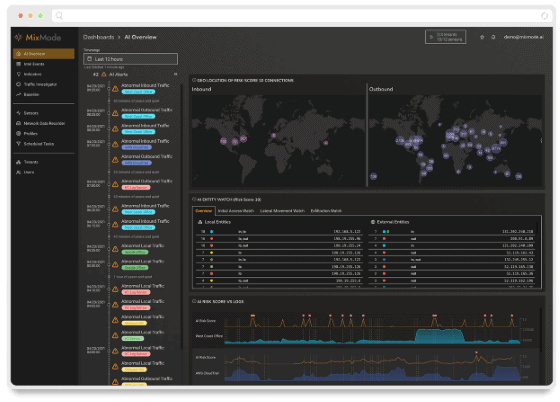Introduction
When it comes to protecting your company’s data, network detection and response (NDR) is a must-have security solution.
NDR provides real-time visibility into what’s happening on the network and helps detect and respond to suspicious activity.
But what exactly is NDR, what are its benefits, and how does it differ from other similar solutions such as XDR?
This guide covers what security professionals need to know about NDR.
I’ll discuss what it is, its key features, the differences between NDR and XDR, what makes it so effective, and what you should consider before implementing an NDR solution in your environment.
The 1-Sentence Definition — What is NDR?
NDR stands for Network Detection and Response.
It is a security solution that combines detection technology with incident response capabilities to provide real-time visibility into what’s happening on the network and detect, respond to, and prevent threats.
The History Of NDR Starts With Network Traffic Analysis
Network Traffic Analysis (NTA) came about as a category in 2019, with the simple concept of providing a more comprehensive view of what was happening on the network.
NTA solutions analyze network traffic packets and metadata to detect anomalies that indicate malicious activity. The idea is you can respond quickly and specifically to potential problems.
Today NTA shares significant overlap with NDR and other security categories.
But the idea is still the same — network security teams need to detect zero-day threats, attacks, and other anomalies that need to be addressed.
What Is Network Traffic Analysis?
NTA allows the analysis of network traffic (hence the name) at a granular, packet-by-packet level.
It enables security teams to quickly identify what’s happening on the network, detect threats, and respond accordingly.
Why Security Teams Turned To NTA In 2020
Historically, security teams were limited to what they could see on the network.
This is still true with NDR, to an extent. NDR solutions provided visibility, but not in depth or speed.
Nevertheless, NDR was born as a category.
Security teams then had the ability to detect what was happening on the network at a much higher level and in real-time.
They discovered deeper insight and enjoyed faster response times. The combined overlap of NDR and NTA became a powerful tool for security teams as it offered a new level of visibility and control.
A (Correctly) Fashionable First Line Of Defense
Did you know? 87 percent of organizations use network traffic analysis (NTA) tools for threat detection and response according to ESG, an IT strategy firm.
In their 2020 study, 43 percent of organizations surveyed said NTA is a “first line of defense” for detecting and responding to threats.
The widespread adoption of NTA solutions is evident in industry market reporting as well: the network traffic analysis solution market is valued at US $2.9B in 2022 and is likely to reach US $8.5B by 2032.
Some of the biggest growth factors are due to the rise of system applications along with the adoption of employee-owned (BYOD), virtualizations, and distributed infrastructure and cloud services.
Rising concerns over security and communication breaches and the need for enhanced network and government spending are also helping to lead the growth of the NTA solutions market.
Gartner defines NTA as “an emerging category of security product using network communications as the primary data source for threat detection and investigation within a network.”
A powerful lens to watch over your network
NTA can be compared to both the microscope and the scientist who interprets what is being seen.
It uses both automated and manual processes to analyze the traffic log in real-time, so your professionals have a chance to respond to anomalies, threats, and attacks.
Another important element of NTA is the interpretation of data.
Machine learning is implemented so that the analysis is helpful and actionable, not more noise for your workforce to sort through.
This powerful lens looks at all levels of communications, giving a comprehensive look at your network traffic and learning from the connections.
Network traffic analysis solutions are focused on all communications, including :
- Traditional TCP/IP style packets
- “Virtual network traffic” crossing a virtual switch (or “vSwitch”)
- Traffic from and within cloud workloads
- API calls to SaaS applications or serverless computing instances.
These solutions enable unprecedented visibility of operational technology and Internet of Things (IoT) networks.
Advanced NTA tools are even effective when network traffic is encrypted.
Initial rounds of NTA development focused on comparing an IP’s behavior with its previous actions.
For instance, if an IP suddenly began communicating with a server in China, the NTA tools would present an alert.
However, in our global and constantly evolving economy, there can be very legitimate reasons for a company to initiate a new relationship with a Chinese customer or company.
Advanced NTA tools can compare not just present with past behavior but also present behavior with that of other entities in the environment.
This cuts down on noise and distraction.
Standard Features of NTA

Built-in analytics
The ability to simply see so much detail is, by itself, not helpful for network security teams.
They also need tools that can assess the high volumes of data and provide meaningful alerts and analysis.
Wide range of monitoring
Quality NTA is able to process a wide variety of inputs and information types, including IoT traffic, protocols, devices, etc.
It’s system-wide and thorough — one might even say it’s obsessive — in its approach to network security.
Cloud traffic monitoring is a newer and quickly advancing area of NTA.
Machine learning baselines
To keep up with ever-changing IT environments, NTA solutions track behaviors that are unique to an entity in comparison with those in their environment.
They also keep track of other entities with which the system is regularly interacting.
These baselines, powered by machine learning, can, therefore, learn what does and does not constitute a threat, as the system inevitably changes these patterns for legitimate purposes.
Ultimately, this means fewer false positives to distract your team.
Network Detection and Response (NDR)
Because NTA tools are able to “get to know” individual entities, they can establish a thorough context for detection and response workflows.
This synthesizes data sources that security professionals formerly needed to sift through, such as DHCP and DNS logs, configuration management databases and directory service infrastructure.
Instead, NTA enables the quick detection of anomalies and enables an informed and timely response.
Network Security’s New Best Friend
The sophisticated level of hacking in today’s world is astonishing and can be frustrating.
The threat of infiltration keeps network security professionals driving forward progress toward new technologies.
NTA is one of the most helpful tools toward narrowing the space between what’s going on in your networks and what you’re able to be aware of. NTA enables you to be more creative and vigilant than the attackers you’re guarding against.
It also makes possible complete surveillance of all forms of network traffic, as they become more intricate and harder to track: cloud computing, DevOps processes, and the IoT, to name a few.
NDR Security — A Quick History
While Network Detection and Response (NDR) came after NTA as a category, the concept has been around since the early 2000s.
At that time, traditional security solutions focused on blocking threats at the perimeter and relied heavily on signature-based detection methods that were not very effective in detecting zero-day threats.
WannaCry in 2017
A well-known example is the infamous WannaCry ransomware attack in 2017 that exploited an exploit in the Windows operating system.
This highlighted the need for a new type of security solution that could detect and respond to threats quickly and effectively.
This led to the development of NDR solutions that combine detection technology with incident response capabilities to detect, respond to, and prevent threats in real-time.
Ever since WannaCry, the demand for NDR solutions has been on the rise and is expected to continue to grow as more organizations realize its value.
SolarWinds Breach Of 2020
This was a perfect example of what can happen when an organization does not have real-time visibility into what’s happening on their network.
The breach went undetected for months and resulted in significant financial losses and reputational damage to the company.
The Many Benefits Of NDR Security
Throughout its history, NDR frameworks and tools have proved to be invaluable for organizations when it comes to protecting their networks and data.
Those key benefits of NDR include:
- Real-time visibility into what’s happening on the network, allowing security teams to detect threats quickly and effectively
- Ability to respond to threats in real-time , minimizing damage
- NDR reduces the complexity of managing multiple security solutions and simplifying governance
- Provides greater oversight for compliance and risk management
- Automated detection and response capabilities
- End-to-end visibility into what’s happening in the network
- Correlation of malicious activity across multiple systems
- Integration with security information and event management (SIEM) tools
- Continuous monitoring to detect suspicious activities
- Simplified incident investigation process
- Improved risk assessment capabilities
- Automation of threat remediation steps
- Increased efficiency for security teams
Network Detection And Response in 2023
Today, the demand for real time solutions that can detect and respond to threats quickly and effectively is at an all-time high.
The reason for this is that attackers are becoming more sophisticated and the top threats are harder to detect than ever.
Just take a look at the Q3 2022 State of InfoSec Report‘s stack rank of top priorities for security teams:
The nice thing is NDR solutions are now more advanced and provide more capabilities than ever before, such as the ability to detect malicious activity on the network, analyze the behavior of endpoints and users, automate incident response workflow processes, and integrate with other security solutions.
And what’s more, they have become far easier to set up and use than traditional security solutions.
NDR vs XDR — What’s The Difference?
In recent years, Extended Detection & Response (XDR) has become a popular buzzword in the cybersecurity world.
Yet many people confuse NDR with XDR.
The two solutions are similar in that they both provide real-time visibility into what’s happening on the network and help detect, respond to, and prevent threats.
However, there are several key differences most organizations should keep in mind:
1 — NDR Is Solely Focused On Network Detection
While XDR solutions are designed to provide visibility and control over a wider range of attack surfaces such as endpoints, cloud environments, and applications.
2 — XDR Solutions Typically Have More Automation Capabilities Than NDR Solutions
A quick example of this is the ability to automate incident response workflows such as escalating alerts and sending notifications.
3 — XDR Solutions Have More Advanced Analytics Capabilities Than NDR Solutions
This includes the ability to analyze and detect anomalous behavior on endpoints, users, or applications in order to uncover hidden threats.
4 — NDR Solutions Are Generally Easier To Set Up Than XDR Solutions
NDR solutions typically require less setup than XDR solutions and can be deployed in a matter of minutes.
5 — NDR Solutions Are Typically More Affordable Than XDR Solutions
NDR solutions are typically more affordable than XDR solutions, making them a more viable option for small and medium-sized businesses.
At the end of the day, the solution that best meets your security needs will depend on what environment you are operating in and what types of threats you need to be protected against.
NDR vs EDR — What’s The Difference?
NDR and EDR (Endpoint Detection and Response) also often get confused.
And there are some important differences to consider.
1 — NDR Solutions Focus On Detecting Malicious Activity At The Network Level While EDR Solutions Look For Malicious Activity On Endpoints
Remember NDR is solely focused on network detection. EDR solutions focus on detecting malicious activity at the endpoint level.
2 — NDR Solutions Allow You To Automate Investigation And Response Workflows While EDR Solutions Allow You To Investigate Threats More Deeply
EDR solutions typically have more advanced capabilities than NDR solutions including the ability to detect, analyze and respond to threats in real time.
3 — NDR solutions are also typically more affordable and require fewer resources to maintain.
Ultimately, the best solution for your organization will depend on what environment you’re operating in and what types of threats you need to be protected against.
MixMode’s patented, self-supervised threat detection platform works in concert with Best of Breed EDR providers to enable the most comprehensive enterprise cyber defense. You can try it here: https://MixMode.ai/try
NDR vs SIEM — What’s The Difference?
The age-old question, what’s the difference between NDR and SIEM (Security Information and Event Management)?
The two solutions are similar in that they both provide visibility into what’s happening on the network.
However, there’s one big difference between the two that’s important to note:
NDR solutions provide event correlation in real time while traditional SIEM solutions require post-incident analysis.
Generally speaking, NDR solutions provide a more comprehensive view of your network. They are able to detect threats in real time and provide automation capabilities that traditional SIEM solutions can’t.
NDR solutions also typically require less resources to maintain and provide more granular visibility than what you’d get with a SIEM solution.
Yet, NDR Is Not Enough For Many Teams — Why?
NDR solutions are essential for security teams as they provide the visibility needed to detect and respond to threats.
However, many organizations are now finding out that NDR is not enough.
The reason being is that NDR solutions can only detect what’s happening on the network — it can’t detect what’s happening on endpoints, what applications are connecting to the network, or what users are doing.
The Threats Are More Sophisticated
Nefarious parties today use a wide range of tactics and techniques to evade traditional security solutions.
They also target multiple areas within an organization such as endpoints, applications, and users.
Attackers have become increasingly adept at bypassing traditional security solutions such as firewalls, anti-malware software, and even NDR solutions.
Humans Have Become The Limiting Factor
Furthermore, NDR solutions lack the automated workflows and advanced analytics capabilities offered by XDR solutions.
This means that security teams are often left playing catch-up and are constantly manually investigating threats.
This is where newer advancements come in.
Ones that provide a more comprehensive security strategy by providing visibility, control, and automation across multiple attack surfaces.
2023 Is The Year Of XDR — And Here’s Why
Healthy organizations today are rethinking their security strategy.
Just take a look at the growth in average weekly attacks in Q3 of last year:
XDR (Extended Detection and Response) provides the visibility needed to detect what’s happening on the network, what applications are connecting to the network, and what users are doing — across multiple attack surfaces.
But XDR Can Be Extremely Expensive
XDR solutions are typically more expensive than NDR solutions and require more resources to maintain.
That being said, they provide organizations with the visibility needed to stay ahead of threats and automate investigation and response workflows.
Ultimately, what’s right for your organization will depend on what environment you’re operating in and what types of threats you need to be protected against.
And Who Knows What Category Of Threats Is Next
Who knows what the next category of threats will be?
Organizations today can’t afford to stand still.
They need visibility, control and automation across multiple attack surfaces in order to stay ahead of what’s happening on their networks.
Practical Examples Of How Organizations Are Working Around The Cost
Below you’ll find examples of how organizations are adopting modern cybersecurity solutions like MixMode, which has been used as an NDR by a number of the nations top security teams, to save cost and identify threats other platforms are missing.
- How a Major US City Rapidly Modernized it’s Cybersecurity
- Why a Large Utility Company Turned to MixMode to Address Utility Grid Vulnerabilities
Conclusion
Network Detection and Response (NDR) solutions have become essential for security teams as they provide the visibility needed to detect threats.
But NDR is no longer enough with attackers becoming increasingly sophisticated and targeting multiple areas within an organization.
Organizations today need to rethink their security strategy and look into Extended Detection and Response (XDR).
XDR offers visibility, control and automation across multiple attack surfaces to stay ahead of what’s happening on their networks.
Ultimately, what’s right for your organization will depend on what environment you’re operating in and what types of threats you need to be protected against.
Other MixMode Articles You Might Like
Maximizing Cybersecurity Savings through Tool Consolidation: A Guide for Enterprises
Cybersecurity is Facing a Cataclysmic Problem
A Proven Strategy For Defending Against Zero-Day Exploits And Attacks — Updated for 2023
How ChatGPT Will Help Hack Your Network


